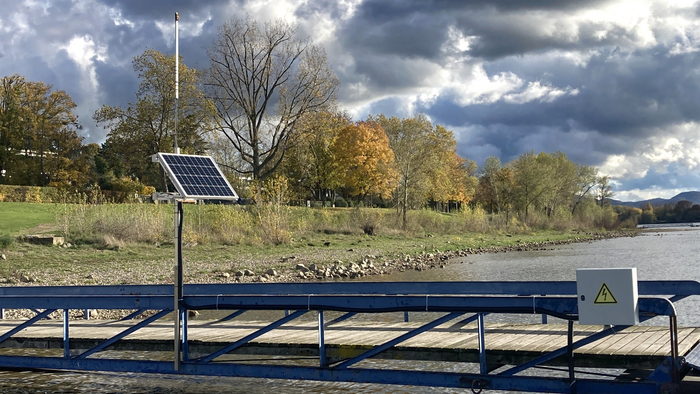Breakthrough low-cost depth sensor records the level of rivers
Researchers at University of Bonn have developed a method that allows the water level of rivers to be monitored around the clock.

[Jan. 2, 2023: Johannes Seiler, University of Bonn]
Can be operated with solar cells and then works completely stand-alone with no maintenance. (Credit: Makan Karegar/University of Bonn)
Researchers at the University of Bonn have developed a method that allows the water level of rivers to be monitored around the clock. The cost-effective sensor is for instance suitable for area-wide flood warning systems. The study has been published in the journal Water Resources Research.
There is a wide range of methods to determine the level of a watercourse - from very simple ones (by yardstick or staff gauge) to advanced radar solutions. But they all have a catch: Most measuring devices can be damaged due to direct exposure to the high water level, many do not allow continuous monitoring, remote reading is difficult or they are simply too expensive.
In Wesel on the Lower Rhine, however, a measuring device that does not have these disadvantages has already been in service for two years: It is cost-effective, reliable and capable of continuously transmitting the water level to an evaluation center via mobile communication. In principle, this means that such a sensor is suitable for providing a densely-distributed network for flood and drought warning systems.
"The core of our device is a low-cost GNSS receiver and antenna," explains Dr. Makan Karegar of the Institute of Geodesy and Geoinformation at the University of Bonn. This is a sensor that can conventionally determine the position of its location with several meter accuracy. It does this using the US GPS satellites and their Russian counterparts, GLONASS. "However, satellite signals can also be used to measure the height of the GNSS antenna above the river surface," Karegar says.
Related Stories
Reflected signals provide information on the water level
This is because the waves transmitted by the satellites are partially picked up directly by the antenna. The rest is reflected from the nearby environment (in this case the water surface) and reaches the receiver via detour. This reflected part therefore travels longer. When superimposed on the directly received signal, it forms certain patterns called interference. These can be used to calculate the distance between the antenna and the water level.
"We can attach the GNSS antenna to any structure, whether it's a bridge, a building, or a tree or fence next to the river," Karegar explains. "From there, it can measure the river level around the clock without contact - to within around 1.5 centimeters on average. And yet it is less likely to be damaged during extreme flooding events."
The accuracy of the method does not match that of a radar-based sensor. However, it is completely sufficient for the intended use. At just under 150 euros, the device is also considerably cheaper than its advanced counterpart.
GNSS interferometric reflectometry (GNSS-IR) geometry for a horizontal planar reflector. A GNSS antenna measures the interference between the direct (blue) and reflected (red) signals. (CREDIT: Water Resources Research)
The GNSS antenna is connected to a microcomputer called a Raspberry Pi. "The device is about the size of a small smartphone; yet it has enough power to calculate water levels from raw data," reports Prof. Dr. Kristine Larson of the Institute of Geodesy and Geoinformation. Thanks to its flexibility and low-power consumption, the microcomputer is very popular among hobbyists, who use it to realize a wide variety of projects. It can be powered by solar cells and then works completely stand alone. It can also transmit its data via mobile network.
Reproduction information on the Internet
"The software we wrote is open source," Larson explains. "So it can be used by anyone for free." The researchers also make all the information about their project available on the Internet. Interested parties can therefore easily reproduce the measuring device.
The Raspberry Pi Reflector (RPR) hardware array comprising: (a) Raspberry Pi 4 Model B (b) Adafruit Feather Adalogger microcontroller (c) Adafruit Global Positioning System (GPS) FeatherWing receiver (d) GPS external antenna (e) Configuration of RPR prototype setup used. This setup uses 4G/LTE dongle modem.
However, the process has one disadvantage: It is only suitable for rivers with width of at least 40 meters. "This is the smallest radius from which the antenna can receive the reflected satellite signal," Karegar says. "If the watercourse is too narrow, most of the reflected signals come from the land." But those involved plan to further optimize their evaluation code. They hope that this will enable them to obtain reliable results for smaller rivers such as the Ahr in Germany, which experienced severe flooding in 2021.
Participating institutions and funding:
In addition to the University of Bonn, the Federal University of Rio Grande do Sul in Brazil was involved in the study. The project was funded by the German Research Foundation (DFG), the National Council for Scientific and Technological Development Brazil (CNPq), and the Rio Grande do Sul State Research Funding Agency (Fapergs).
For more science and technology news stories check out our New Innovations section at The Brighter Side of News.
Note: Materials provided above by University of Bonn. Content may be edited for style and length.
Like these kind of feel good stories? Get the Brighter Side of News' newsletter.
Joshua Shavit
Science & Technology Writer | AI and Robotics Reporter
Joshua Shavit is a Los Angeles-based science and technology writer with a passion for exploring the breakthroughs shaping the future. As a contributor to The Brighter Side of News, he focuses on positive and transformative advancements in AI, technology, physics, engineering, robotics and space science. Joshua is currently working towards a Bachelor of Science in Business Administration at the University of California, Berkeley. He combines his academic background with a talent for storytelling, making complex scientific discoveries engaging and accessible. His work highlights the innovators behind the ideas, bringing readers closer to the people driving progress.



